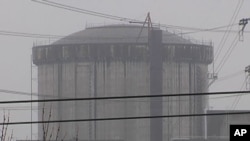March 28 marks the 32nd anniversary of the United States' worst nuclear accident. The reactor at Three Mile Island in central Pennsylvania experienced a near meltdown. Although not nearly the tragedy of Chernobyl in Ukraine, or Fukushima in Japan, Three Mile Island caused a three-decade pause in nuclear energy advancement in the U.S. and a review of nuclear plant policies nationwide.
Beyond the hills of Middletown, Pennsylvania, an eerie sight rises through the haze. Four nuclear cooling towers. And a reactor that caused the worst nuclear accident in the United States. Reactor Number 2 at Three Mile Island.
Rosalie Taylor was raising two boys in Middletown when she learned radiation may have leaked out of the plant. Safety officials told residents to stay inside.
"You just sat in your house with everything closed and wondering if there was going to be a meltdown or not," recalled Taylor.
At first, then-Governor Dick Thornburgh said no. But the next day, he recommended the evacuation of pregnant women and small children. Now 32 years later, he said "We didn’t want to undertake an evacuation unnecessarily and we were constantly assessing the info [information] we had to see if it was necessary."
More than 120,000 people evacuated.
"It's a funny sensation to not know if you are going to come back to your home," noted Taylor. "I had to take a few things that were important to me. And those few things are the two albums you saw of my sons. And, birth certificates."
Dentist Sam Selcher still works out of the same office as he did in 1979. Rather than evacuating, he stayed to handle emergencies.
"All of my employees live within a 5-mile radius of Three Mile Island," said Selcher. "I told them to wear their film badges 24 hours a day and keep it with them wherever they were."
The devices showed no radiation exposure. Four days after the incident, President Jimmy Carter arrived.
"I think people really and simply said, 'If it's safe enough for the president and the governor to walk around in that plant it must be pretty safe," added Thornburgh.
Two days later, the incident was over. The containment structure worked. Most of the radiation did not escape. Years later, scientists determined that a jammed valve had caused cooling water to drain from the reactor core.
Ralph DeSantis is with the power company that runs Three Mile Island. "With that water coming out, about half the fuel core became uncovered and that's where the partial meltdown occurred," DeSantis explained.
Investigators blamed the accident on equipment malfunction, human error and lack of training. Because of Three Mile Island, every U.S. nuclear power plant must now have a control room simulator, designed to be an exact replica of the nerve center in the plant.
The simulators feature alarm panels that are prioritized by color and sound - so operators know which alarms to respond to first. Unlike 1979, when 400 different alarms blared, overwhelming operators.
"As a result of Three Mile Island, both our regulator [the NRC] and the industry looked in the mirror and said, 'We need to improve our operator training. We need to improve our emergency response capability,'" said Tony Pietrangelo with the Nuclear Energy Institute.
Three MiIe Island temporarily stalled the growth of nuclear energy in the United States. It would be 30 years before the U.S. Nuclear Regulatory Commission would even review an application for a new power plant. Reactor 2 at Three Mile Island was permanently shut down, but Reactor 1 and its cooling towers continue to operate.











